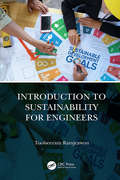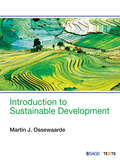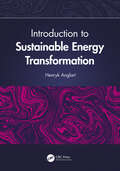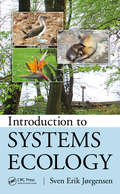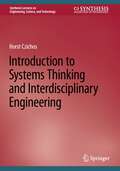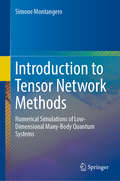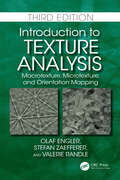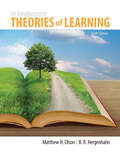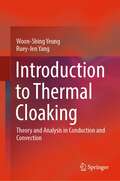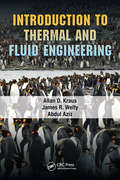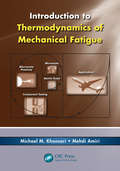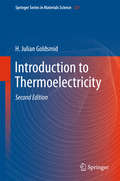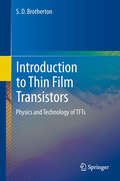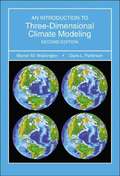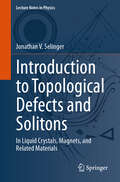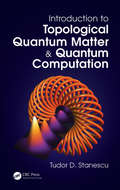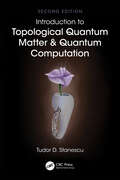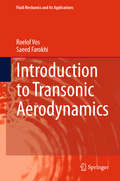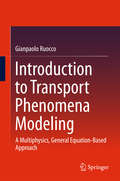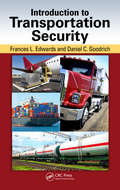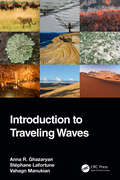- Table View
- List View
Introduction to Sustainability for Engineers
by Toolseeram RamjeawonIntroduction to Sustainability for Engineers aims to incorporate sustainability into curricula for undergraduate engineering students. The book starts with an introduction to the concept of sustainability, outlining core principles for sustainable development to guide engineering practice and decision making, including key tools aimed at enabling, measuring and communicating sustainability. It also describes concepts as life cycle assessment, environmental economics, related institutional architecture and policy framework, business context of sustainability, and sustainable buildings and infrastructure. Appendices at the end of the book presents a summary of key concepts, strategies and tools introduced in the main text. Five Key Benefits: A comprehensive textbook for engineering students to develop competency in sustainability. Presents a framework for engineers to put sustainability into practice. Presents the link between sustainability and the design process. It shows the application of a sustainable engineering design process for putting sustainability into practice. There are well woven case studies and links to websites for learning in various engineering disciplines. Includes challenging exercises at the end of each chapter that will inspire students and stimulate discussion in the class.
Introduction to Sustainable Development
by Martin J. OssewaardeThe book provides insights into the major challenges to sustainable development, and encourages and enables readers to participate in the sustainability transition. Sustainable development is increasingly identified as more of a necessity than an option or luxury. Being multidisciplinary in nature, it requires the knowledge of scientific, economic and social sides of problems and their solutions, and how they interact. This book presents a critical account of the strengths and weaknesses in the pursuit of sustainability, with special reference to the developing world perspective. It motivates readers to work towards making truly inclusive and environmentally sustainable choices. It also inspires them to be engaged as 'change-makers' for more sustainable types of development in their families, companies and communities. The book is divided into three parts. Part 1 makes the case for sustainable development and paints the overall vision; Part 2 presents the stakeholders and tools that are needed in the transition to a sustainable future and Part 3 contains application areas that help the reader see how the previous parts come to play a role in the major issues of contemporary times. Key Features: Critically links sustainable development goals with technology, infrastructure as well as human behaviour and institutions. Follows thematic presentation across chapters to enable understanding of sustainability in the context of history, worldviews and the transition. Applies four worldviews to the theme of every chapter to encourage readers recognise different perspectives and enable them to form their own opinion. Discusses behavioural action and attitudes to help students investigate their own values and motivation.
Introduction to Sustainable Energy Transformation
by Henryk AnglartThis textbook provides an accessible introduction to various energy transformation technologies and their influences on the environment. Here the energy transformation is understood as any physical process induced by humans, in which energy is intentionally transformed from one form to another. This book provides an accessible introduction to the subject: covering the theory, principles of design, operation, and efficiency of the systems in addition to discerning concepts such as energy, entropy, exergy, efficiency, and sustainability. It is not assumed that readers have any previous exposure to such concepts as laws of thermodynamics, entropy, exergy, fluid mechanics or heat transfer, and is therefore an ideal textbook for advanced undergraduate students. Key features: Represents a complete source of information on sustainable energy transformation systems and their externalities. Includes all existing and major emerging technologies in the field. Chapters include numerous examples and problems for further learning opportunities.
Introduction to Systems Ecology (Applied Ecology and Environmental Management)
by Sven JorgensenPossibly the first textbook to present a practically applicable ecosystems theory, Introduction to Systems Ecology helps readers understand how ecosystems work and how they react to disturbances. It demonstrates-with many examples and illustrations-how to apply the theory to explain observations and to make quantitative calculations and predictions
Introduction to Systems Thinking and Interdisciplinary Engineering (Synthesis Lectures on Engineering, Science, and Technology)
by Horst CzichosThis concise textbook introduces a systems approach to technology, describing tribological, mechatronic, cyber-physical systems, and the technologic concept of Industry 4.0 to students in a range of engineering domains. “Technology” in this book refers to the totality of human-made, benefit-oriented products, based on engineered combinations of material, energy and information. Dr. Czichos examines technology in this volume in the context of systems thinking with regard to the following main technology areasTechnical systems with “interacting surfaces in relative motion” especially in mechanical engineering, production, and transport; including the analysis of friction-induced energy losses and wear-induced materials dissipation. Technical systems that require a combination of mechanics, electronics, controls, and computer engineering for needs of industry and society. Technical systems with a combination of mechatronics and internet communication. Cyber-physical Systems for the digitalization of Industry in the development project Industry 4.0.Considers technology as combination of the physical world and the digital virtual world of information and communication.Describes the product cycle of technical systems and the corner stones of technology: material, energy and information.Presents a holistic view of technology and engineering.
Introduction to Tensor Network Methods: Numerical simulations of low-dimensional many-body quantum systems
by Simone MontangeroThis volume of lecture notes briefly introduces the basic concepts needed in any computational physics course: software and hardware, programming skills, linear algebra, and differential calculus. It then presents more advanced numerical methods to tackle the quantum many-body problem: it reviews the numerical renormalization group and then focuses on tensor network methods, from basic concepts to gauge invariant ones. Finally, in the last part, the author presents some applications of tensor network methods to equilibrium and out-of-equilibrium correlated quantum matter.The book can be used for a graduate computational physics course. After successfully completing such a course, a student should be able to write a tensor network program and can begin to explore the physics of many-body quantum systems. The book can also serve as a reference for researchers working or starting out in the field.
Introduction to Texture Analysis: Macrotexture, Microtexture, and Orientation Mapping
by Valerie Randle Olaf Engler Stefan ZaeffererReflecting emerging methods and the evolution of the field, Introduction to Texture Analysis: Macrotexture, Microtexture, and Orientation Mapping keeps mathematics to a minimum in covering both traditional macrotexture analysis and more advanced electron-microscopy-based microtexture analysis. The authors integrate the two techniques and address the subsequent need for a more detailed explanation of philosophy, practice, and analysis associated with texture analysis. The book illustrates approaches to orientation measurement and interpretation and elucidates the fundamental principles on which measurements are based. Thoroughly updated, this Third Edition of a best-seller is a rare introductory-level guide to texture analysis. Discusses terminology associated with orientations, texture, and their representation, as well as the diffraction of radiation, a phenomenon that is the basis for almost all texture analysis. Covers data acquisition, as well as representation and evaluation related to the well-established methods of macrotexture analysis. Updated to include experimental details of the latest transmission or scanning electron microscope-based techniques for microstructure analysis, including electron backscatter diffraction (EBSD). Describes how microtexture data are evaluated and represented and emphasizes the advances in orientation microscopy and mapping, and advanced issues concerning crystallographic aspects of interfaces and connectivity. Offers new and innovative grain boundary descriptions and examples. This book is an ideal tool to help readers in the materials sciences develop a working understanding of the practice and applications of texture.
Introduction to Theories of Learning: Ninth Edition
by Matthew H. OlsonDefines learning and shows how the learning process is studied. Clearly written and user-friendly, Introduction to the Theories of Learning places learning in its historical perspective and provides appreciation for the figures and theories that have shaped 100 years of learning theory research. The 9th edition has been updated with the most current research in the field. With Pearson's MySearchLab with interactive eText and Experiment's Tool, this program is more user-friendly than ever. Learning Goals Upon completing this book, readers should be able to: Define learning and show how the learning process is studied Place learning theory in historical perspective Present essential features of the major theories of learning with implications for educational practice Note: MySearchLab does not come automatically packaged with this text. To purchase MySearchLab, please visit: www.mysearchlab.com or you can purchase a ValuePack of the text + MySearchLab (at no additional cost).
Introduction to Thermal Cloaking: Theory and Analysis in Conduction and Convection
by Woon-Shing Yeung Ruey-Jen YangThis book introduces the fundamental concepts of thermal cloaking based on transformation theory and bilayer theory, under the conduction and convection heat transfer modes. It focuses on thermal cloaking with detailed explanations of the underlying theoretical bases leading to the primary thermal cloaking results in open literature, from an engineering perspective, and with practical application in mind. Also, the authors strive to present the materials with an emphasis on the related physical phenomena and interpretation, to the extent possible. Through this book, engineering students can grasp the fundamental ideas of thermal cloaking and the associated mathematics, thus being better able to initiate their own research and explore new ideas in thermal cloaking. While not intended to be a general reference in the vast field of thermal cloaking research, this book is a unique monograph addressing the theoretical and analytical aspects of thermal cloaking within the scope mentioned above. This book also contains many independent analytical solutions to thermal cloaking problems that are not available in open literature. It is suitable for a three-credit graduate or advanced undergraduate course in engineering science.
Introduction to Thermal and Fluid Engineering
by Allan D. Kraus James R. Welty Abdul AzizIntroduction to Thermal and Fluid Engineering combines coverage of basic thermodynamics, fluid mechanics, and heat transfer for a one- or two-term course for a variety of engineering majors. The book covers fundamental concepts, definitions, and models in the context of engineering examples and case studies. It carefully explains the methods used to evaluate changes in equilibrium, mass, energy, and other measurable properties, most notably temperature. It then also discusses techniques used to assess the effects of those changes on large, multi-component systems in areas ranging from mechanical, civil, and environmental engineering to electrical and computer technologies.Includes a motivational student study guide on downloadable resources to promote successful evaluation of energy systemsThis material helps readers optimize problem solving using practices to determine equilibrium limits and entropy, as well as track energy forms and rates of progress for processes in both closed and open thermodynamic systems. Presenting a variety of system examples, tables, and charts to reinforce understanding, the book includes coverage of: How automobile and aircraft engines work Construction of steam power plants and refrigeration systems Gas and vapor power processes and systems Application of fluid statics, buoyancy, and stability, and the flow of fluids in pipes and machinery Heat transfer and thermal control of electronic components Keeping sight of the difference between system synthesis and analysis, this book contains numerous design problems. It would be useful for an intensive course geared toward readers who know basic physics and mathematics through ordinary different
Introduction to Thermodynamics of Mechanical Fatigue
by Michael M. Khonsari Mehdi AmiriFatigue is probabilistic in nature and involves a complex spectrum of loading history with variable amplitudes and frequencies. Yet most available fatigue failure prediction methods are empirical and concentrate on very specific types of loading. Taking a different approach, Introduction to Thermodynamics of Mechanical Fatigue examines the treatmen
Introduction to Thermoelectricity
by H. Julian GoldsmidThis second edition is acomprehensive introduction to all aspects of thermoelectric energy conversion. It covers both theory and practice. The book is timely as it refers to the manyimprovements that have come about in the last few years through the use ofnanostructures. The concept of semiconductor thermoelements led to majoradvances during the second half of the twentieth century, making Peltier refrigerationa widely used technique. The latest materials herald thermoelectric generationas the preferred technique for exploiting low-grade heat. The book shows howprogress has been made by increasing the thermal resistivity of the latticeuntil it is almost as large as it is for glass. It points the way towards theattainment of similar improvements in the electronic parameters. It does notneglect practical considerations, such as the desirability of makingthermocouples from inexpensive and environmentally acceptable materials. Thesecond edition was extended to also include recent advances in thermoelectricenergy conversion, particularly the production of bulk nanostructures, newmaterials with higher thermoelectric figures to use the possibility of largescale thermoelectric generation, as part of the worldwide strategy for makingbetter use of energy resources. This book guides the newcomertowards the state of the art and shows the principles for further advancementto those who are already familiar with the subject. The author has been able todraw on his long experience to cover the science and technology in a balancedway while drawing on the expertise of others who have made major contributionsto the field.
Introduction to Thin Film Transistors
by S. D. BrothertonIntroduction to Thin Film Transistors reviews the operation, application and technology of the main classes of thin film transistor (TFT) of current interest for large area electronics. The TFT materials covered include hydrogenated amorphous silicon (a-Si:H), poly-crystalline silicon (poly-Si), transparent amorphous oxide semiconductors (AOS), and organic semiconductors. The large scale manufacturing of a-Si:H TFTs forms the basis of the active matrix flat panel display industry. Poly-Si TFTs facilitate the integration of electronic circuits into portable active matrix liquid crystal displays, and are increasingly used in active matrix organic light emitting diode (AMOLED) displays for smart phones. The recently developed AOS TFTs are seen as an alternative option to poly-Si and a-Si:H for AMOLED TV and large AMLCD TV applications, respectively. The organic TFTs are regarded as a cost effective route into flexible electronics. As well as treating the highly divergent preparation and properties of these materials, the physics of the devices fabricated from them is also covered, with emphasis on performance features such as carrier mobility limitations, leakage currents and instability mechanisms. The thin film transistors implemented with these materials are the conventional, insulated gate field effect transistors, and a further chapter describes a new thin film transistor structure: the source gated transistor, SGT. The driving force behind much of the development of TFTs has been their application to AMLCDs, and there is a chapter dealing with the operation of these displays, as well as of AMOLED and electrophoretic displays. A discussion of TFT and pixel layout issues is also included. For students and new-comers to the field, introductory chapters deal with basic semiconductor surface physics, and with classical MOSFET operation. These topics are handled analytically, so that the underlying device physics is clearly revealed. These treatments are then used as a reference point, from which the impact of additional band-gap states on TFT behaviour can be readily appreciated. This reference book, covering all the major TFT technologies, will be of interest to a wide range of scientists and engineers in the large area electronics industry. It will also be a broad introduction for research students and other scientists entering the field, as well as providing an accessible and comprehensive overview for undergraduate and postgraduate teaching programmes.
Introduction to Three-Dimensional Climate Modeling
by Warren WashingtonMost descriptions of climatic modeling assume readers to have a great deal of previous knowledge about atmospheric or ocean dynamics, but Washington (US National Center for Atmospheric Research) and Parkinson (US National Aeronautics and Space Administration) address readers in the atmospheric science, geography, geology, hydrology, oceanography, and ecology who may be only vaguely aware of climate models. They explain what the models are attempting to simulate, how they are constructed, what they have succeeded in simulating, and how they are being used for evaluation and prediction. Annotation ©2005 Book News, Inc. , Portland, OR (booknews. com)
Introduction to Tissue Engineering
by Ravi BirlaCovering a progressive medical field, Tissue Engineering describes the innovative process of regenerating human cells to restore or establish normal function in defective organs. As pioneering individuals look ahead to the possibility of generating entire organ systems, students may turn to this textbook for a comprehensive understanding and preparation for the future of regenerative medicine. This book explains chemical stimulations, the bioengineering of specific organs, and treatment plans for chronic diseases. It is a must-read for tissue engineering students and practitioners.
Introduction to Topological Defects and Solitons: In Liquid Crystals, Magnets, and Related Materials (Lecture Notes in Physics #1032)
by Jonathan V. SelingerThis textbook introduces topological defects and solitons at a level suitable for advanced undergraduates and beginning graduate students in physics and materials science. It avoids the formal mathematics of topology, and instead concentrates on the physical properties of these topological structures. The first half of the book concentrates on fundamental principles of defects and solitons, and illustrates these principles with a single example—the xy model for 2D magnetic order. It begins by defining the concept of a winding number, and uses this concept to describe the topology of defects (vortices or disclinations) and solitons (domain walls), carefully identifying the similarities and differences between these two types of topological structures. It then goes on to discuss physical properties of defects and solitons, including free energy, dynamics, statistical mechanics, and coupling with curvature. It shows how these concepts emerge from a theory with variable magnitude of order, and hence how topology can be viewed as an approximation to physics. The second half goes on to explore a wider range of topological defects and solitons. First, it considers more complex types of order—2D nematic liquid crystals, 3D magnetic or liquid-crystal order, 2D or 3D crystalline solids—and shows how each type of order leads to specific topological structures. Next, it discusses defects and solitons that are characterized by 2D or 3D measuring surfaces, not just 1D loops, including hedgehogs, skyrmions, and hopfions. These structures are more complex, but they can still be understood using the same fundamental principles. A final chapter describes the formation of phases with regular arrays of defects or solitons.
Introduction to Topological Quantum Matter & Quantum Computation
by Tudor D. StanescuWhat is "topological" about topological quantum states? How many types of topological quantum phases are there? What is a zero-energy Majorana mode, how can it be realized in a solid state system, and how can it be used as a platform for topological quantum computation? What is quantum computation and what makes it different from classical computation? Addressing these and other related questions, Introduction to Topological Quantum Matter & Quantum Computation provides an introduction to and a synthesis of a fascinating and rapidly expanding research field emerging at the crossroads of condensed matter physics, mathematics, and computer science. Providing the big picture, this book is ideal for graduate students and researchers entering this field as it allows for the fruitful transfer of paradigms and ideas amongst different areas, and includes many specific examples to help the reader understand abstract and sometimes challenging concepts. It explores the topological quantum world beyond the well-known topological insulators and superconductors and emphasizes the deep connections with quantum computation. It addresses key principles behind the classification of topological quantum phases and relevant mathematical concepts and discusses models of interacting and noninteracting topological systems, such as the torric code and the p-wave superconductor. The book also covers the basic properties of anyons, and aspects concerning the realization of topological states in solid state structures and cold atom systems. Quantum computation is also presented using a broad perspective, which includes fundamental aspects of quantum mechanics, such as Bell's theorem, basic concepts in the theory of computation, such as computational models and computational complexity, examples of quantum algorithms, and elements of classical and quantum information theory.
Introduction to Topological Quantum Matter & Quantum Computation
by Tudor D. StanescuWhat is "topological" about topological quantum states? How many types of topological quantum phases are there? What is a zero-energy Majorana mode, how can it be realized in a solid-state system, and how can it be used as a platform for topological quantum computation? What is quantum computation and what makes it different from classical computation?Addressing these and other related questions, Introduction to Topological Quantum Matter & Quantum Computation provides an introduction to and a synthesis of a fascinating and rapidly expanding research field emerging at the crossroads of condensed matter physics, mathematics, and computer science. Providing the big picture and emphasizing two major new paradigms in condensed matter physics – quantum topology and quantum information – this book is ideal for graduate students and researchers entering this field, as it allows for the fruitful transfer of ideas amongst different areas, and includes many specific examples to help the reader understand abstract and sometimes challenging concepts. It explores the topological quantum world beyond the well-known topological insulators and superconductors and unveils the deep connections with quantum computation. It addresses key principles behind the classification of topological quantum phases and relevant mathematical concepts and discusses models of interacting and noninteracting topological systems, such as the toric code and the p-wave superconductor. The book also covers the basic properties of anyons, and aspects concerning the realization of topological states in solid state structures and cold atom systems.Topological quantum computation is also presented using a broad perspective, which includes elements of classical and quantum information theory, basic concepts in the theory of computation, such as computational models and computational complexity, examples of quantum algorithms, and key ideas underlying quantum computation with anyons. This new edition has been updated throughout, with exciting new discussions on crystalline topological phases, including higher-order topological insulators; gapless topological phases, including Weyl semimetals; periodically-driven topological insulators; and a discussion of axion electrodynamics in topological materials.Key Features:· Provides an accessible introduction to this exciting, cross-disciplinary area of research.· Fully updated throughout with new content on the latest result from the field.· Authored by an authority on the subject.Tudor Stanescu is a professor of Condensed Matter Theory at West Virginia University, USA. He received a B.S. in Physics from the University of Bucharest, Romania, in 1994 and a Ph.D. in Theoretical Physics from the University of Illinois at Urbana Champaign in 2002. He was a Postdoctoral Fellow at Rutgers University and at the University of Maryland from 2003 to 2009. He joined the Department of Physics and Astronomy at West Virginia University in Fall 2009. Prof. Stanescu’s research interests encompass a variety of topics in theoretical condensed matter physics including topological insulators and superconductors, topological quantum computation, ultra-cold atom systems in optical lattices, and strongly correlated materials, such as, for example, cuprate high-temperature superconductors. His research uses a combination of analytical and numerical tools and focuses on understanding the emergence of exotic states of matter in solid state and cold atom structures, for example, topological superconducting phases that host Majorana zero modes, and on investigating the possibilities of exploiting these states as physical platforms for quantum computation.
Introduction to Transonic Aerodynamics
by Saeed Farokhi Roelof VosWritten to teach students the nature of transonic flow and its mathematical foundation, this book offers a much-needed introduction to transonic aerodynamics. The authors present a quantitative and qualitative assessment of subsonic, supersonic and transonic flow around bodies in two and three dimensions. The book reviews the governing equations and explores their applications and limitations as employed in modeling and computational fluid dynamics. Some concepts, such as shock and expansion theory, are examined from a numerical perspective. Others, including shock-boundary-layer interaction, are discussed from a qualitative point of view. The book includes 60 examples and more than 200 practice problems. The authors also offer analytical methods such as Method of Characteristics (MOC) that allow readers to practice with the subject matter. The result is a wealth of insight into transonic flow phenomena and their impact on aircraft design, including compressibility effects, shock and expansion waves, shock-boundary-layer interaction and aeroelasticity.
Introduction to Transport Phenomena Modeling: A Multiphysics, General Equation-Based Approach
by Gianpaolo RuoccoThis textbook offers an introduction to multiple, interdependent transport phenomena as they occur in various fields of physics and technology like transport of momentum, heat, and matter. These phenomena are found in a number of combined processes in the fields of chemical, food, biomedical, and environmental sciences. The book puts a special emphasis on numerical modeling of both purely diffusive mechanisms and macroscopic transport such as fluid dynamics, heat and mass convection. To favor the applicability of the various concepts, they are presented with a simplicity of exposure, and synthesis has been preferred with respect to completeness. The book includes more than 130 graphs and figures, to facilitate the understanding of the various topics. It also presents many modeling examples throughout the text, to control that the learned material is properly understood.
Introduction to Transportation Security
by Frances L. Edwards Daniel C. GoodrichTransportation is the lifeline of any nation, connecting people, supporting the economy, and facilitating the delivery of vital goods and services. The 9/11 attacks and other attacks on surface transportation assets, including the bombings in Madrid, London, Moscow, and Mumbai demonstrate the vulnerability of the open systems to disruption and the
Introduction to Traveling Waves
by Stéphane Lafortune Anna R. Ghazaryan Vahagn ManukianIntroduction to Traveling Waves is an invitation to research focused on traveling waves for undergraduate and masters level students. Traveling waves are not typically covered in the undergraduate curriculum, and topics related to traveling waves are usually only covered in research papers, except for a few texts designed for students. This book includes techniques that are not covered in those texts. Through their experience involving undergraduate and graduate students in a research topic related to traveling waves, the authors found that the main difficulty is to provide reading materials that contain the background information sufficient to start a research project without an expectation of an extensive list of prerequisites beyond regular undergraduate coursework. This book meets that need and serves as an entry point into research topics about the existence and stability of traveling waves. Features Self-contained, step-by-step introduction to nonlinear waves written assuming minimal prerequisites, such as an undergraduate course on linear algebra and differential equations. Suitable as a textbook for a special topics course, or as supplementary reading for courses on modeling. Contains numerous examples to support the theoretical material. Supplementary MATLAB codes available via GitHub.
Introduction to Tsallis Entropy Theory in Water Engineering
by Vijay P. SinghFocuses On an Emerging Field in Water EngineeringA broad treatment of the Tsallis entropy theory presented from a water resources engineering point of view, Introduction to Tsallis Entropy Theory in Water Engineering fills a growing need for material on this theory and its relevant applications in the area of water engineering. This self-contained
Introduction to UAV Systems (Aerospace Series)
by Mohammad H. Sadraey Paul G. Fahlstrom Thomas J. GleasonIntroduction to UAV Systems The latest edition of the leading resource on unmanned aerial vehicle systems In the newly revised Fifth Edition of Introduction to UAV Systems, an expert team of aviators, engineers, and researchers delivers the fundamentals of UAV systems for both professionals and students in UAV courses. Suitable for students in Aerospace Engineering programs, as well as Flight and Aeronautics programs, this new edition now includes end-of-chapter questions and online instructor ancillaries that make it an ideal textbook. As the perfect complement to the author’s Design of Unmanned Aerial Systems, this book includes the history, classes, and missions of UAVs. It covers fundamental topics, like aerodynamics, stability and control, propulsion, loads and structures, mission planning, payloads, and communication systems. Brand-new materials in areas including autopilots, quadcopters, payloads, and ground control stations highlight the latest industry technologies. The authors also discuss: A thorough introduction to the history of unmanned aerial vehicles, including their use in various conflicts, an overview of critical UAV systems, and the Predator/Reaper A comprehensive exploration of the classes and missions of UAVs, including several examples of UAV systems, like Mini UAVs, UCAVs, and quadcopters Practical discussions of air vehicles, including coverage of topics like aerodynamics, flight performance, stability, and control In-depth examinations of propulsion, loads, structures, mission planning, control systems, and autonomy Perfect for professional aeronautical and aerospace engineers, as well as students and instructors in courses like Unmanned Aircraft Systems Design and Introduction to Unmanned Aerial Systems, Introduction to UAV Systems is an indispensable resource for anyone seeking coverage of the latest industry advances and technologies in UAV and UAS technology.
Introduction to Ultrafast Phenomena: From Femtosecond Magnetism to High-Harmonic Generation
by Thomas F. George Wolfgang Hübner Guo-ping Zhang Georgios Lefkidis Mitsuko MurakamiThis book, the first of this kind, provides a comprehensive introduction to ultrafast phenomena, covering the fundamentals of ultrafast spin and charge dynamics, femtosecond magnetism, all-optical spin switching, and high-harmonic generation. It covers the experimental tools, including ultrafast pump-probe experiments, and theoretical methods including quantum chemistry and density functional theory, both time-independent and time-dependent. The authors explain in clear language how an ultrafast laser pulse is generated experimentally, how it can induce rapid responses in electrons and spins in molecules, nanostructures and solids (magnetic materials and superconductors), and how it can create high-harmonic generation from atoms and solids on the attosecond timescale. They also show how this field is driving the next generation of magnetic storage devices through femtomagnetism, all-optical spin switching in ferrimagnets and beyond, magnetic logic in magnetic molecules, and ultrafast intense light sources, incorporating numerous computer programs, examples, and problems throughout, to show how the beautiful research can be done behind the scene. Key features: · Provides a clear introduction to modern ultrafast phenomena and their applications in physics, chemistry, materials sciences, and engineering. · Presents in detail how high-harmonic generation occurs in atoms and solids. · Explains ultrafast demagnetization and spin switching, a new frontier for development of faster magnetic storage devices. · Includes numerous worked-out examples and problems in each chapter, with real research codes in density functional theory and quantum chemical calculations provided in the chapters and in the Appendices. This book is intended for undergraduate and graduate students, researchers in physics, chemistry, biology, materials sciences, and engineering.
